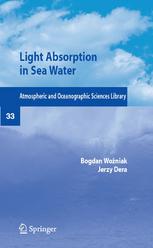

Most ebook files are in PDF format, so you can easily read them using various software such as Foxit Reader or directly on the Google Chrome browser.
Some ebook files are released by publishers in other formats such as .awz, .mobi, .epub, .fb2, etc. You may need to install specific software to read these formats on mobile/PC, such as Calibre.
Please read the tutorial at this link: https://ebookbell.com/faq
We offer FREE conversion to the popular formats you request; however, this may take some time. Therefore, right after payment, please email us, and we will try to provide the service as quickly as possible.
For some exceptional file formats or broken links (if any), please refrain from opening any disputes. Instead, email us first, and we will try to assist within a maximum of 6 hours.
EbookBell Team

5.0
28 reviewsThis book takes a fresh, holistic approach to the problems of light absorption and absorbers in seawaters, discussing the fundamentals of light absorption at various depths in seawaters of different trophicity by absorbers of diverse origin. The authors have drawn their information from a substantial body of contemporary research results published in the subject literature (over 700 references) as well as their own work during the last 30 years. No other book presently available examines the issues of light absorption and absorbers in seawaters in such a manner.
The book is intended primarily for students, engineers and scientists professionally involved with the marine environment; nevertheless, the authors hope that it will also find favor among all who take an interest in the nature of our Earth, especially the seas and oceans.
The components most strongly differentiating the various types of sea/ocean waters from the optical point of view – the water itself, the organic and inorganic substances dissolved in it, and the manifold particles suspended in it – receive comprehensive treatment. The spectral absorption of light by pure water in its various states of matter and by atoms and ions of sea salt is also given ample coverage. The interaction of light with various kinds of organic molecules is analyzed in detail, as are the light absorption spectra of the principal groups of these substances present in the sea in dissolved form. The physical and chemical properties, as well as the optical constants, of organic and inorganic suspended particulate matter (SPM), are discussed in the context of their relationship to the light absorption properties of SPM. Special emphasis is placed on the role of the phytoplankton and the pigments it contains which are particularly strong and important absorbers of visible light in the sea.
The authors are professors of physics with practical experience in the field of marine research going back 35 (BW) and 45 (JD) years. They are also the authors of a large number of research papers and several books, e.g., J. Dera, Marine Physics (Elsevier (The Netherlands) and PWN (Poland)), W. Smekot-Wensierski, B. Wozniak et al. Absorptionseigenschaften des marinen Phytoplanktons [Absorption properties of marine phytoplankton] (GKSS-Forschungszentrum Geesthacht GmbH, Germany).